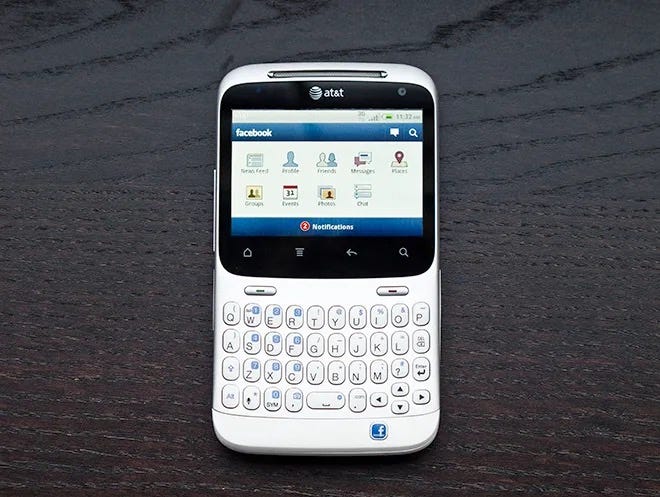Facebook Phone Flop: What Happens When Innovation Trumps User Value


“Celebrating innovation for its own sake is in bad taste.” — Evgeny Morozov
Does anyone remember seeing this monstrosity? I do. The Facebook phone was announced the same year as the iPhone 4s, a device designed to delight. While an MVP for a Facebook first phone, I can’t say it was a big hit, let alone a limited success. Over a couple of years, it evolved to look more like the iPhone but never hit its stride, with AT&T ultimately discounting the last model, the HTC First, to $0.99. The result — Facebook never carved out a significant position in the mobile hardware space.
Why did this happen? What was the cause of the flop? While important, the real question is why the phone existed in the first place. Did anyone check with users to see if they wanted a Facebook first phone? And if they did, would the first version cross the threshold of utility, let alone value and delight?
The point — sometimes, just sometimes, product people can become enamored with an idea, an innovation, or a shiny object. Unfortunately, when they do, disaster often ensues as they skip ahead, moving right to build. Never a good thing, I can assure you. Whether the Facebook phone or Cheetos lip balm, some products, no matter how strong the idea or innovation, aren’t meant to be.
My advice on this — if you do choose to chase the shiny object, do your homework. And certainly do not let the experiment run for years without success or a clear, purposeful way to delight your user.

Avoiding innovation for innovation’s sake
Rule #1 — Your innovation needs three elements to move forward. A purpose that benefits your company and your user. Utility that delivers repeat value. And the delight factor. Without these basics, the innovation will flop no matter how ‘good the idea is.’
Repeat it with me — Purpose →Utility → Value → Delight
- Purpose — What’s the compelling reason for the innovation existing?
- Utility — Does it do what the user wants, solving a problem?
- Value — Does the user get something out of it over and over again?
- Delight — Does the user enjoy using the product innovation?
If you dissect the Facebook phone, it’s understandable from a strategy standpoint — own the mobile platform, own the experience, own the entry point = more time spent on Facebook. However, simply aiming to dominate mobile computing with a Facebook first phone, despite domination being a clear purpose, isn’t a compelling reason for users to give you their cash or time.
Ultimately, the Facebook phone, an innovative experiment in mobile computing, failed as it lacked a user-centric purpose, utility, value, and delight. More on that is below.
- Purpose — The phone did have a clear purpose for Facebook, but not for its users — there is no real reason for the phone to exist. At least not a compelling one. A shortcut to a Facebook first experience is no different than what they could get through an app on a much better phone.
- Utility — Does a phone with a Facebook shortcut button and a Facebook first operating system have utility? Can’t you access Facebook and other useful apps on better-designed phones — the iPhone, for example? What’s the utility of the phone?
- Value — Does a phone with a Facebook shortcut button and a Facebook first operating system create enough value for users to switch? Clearly, a no, not even at a $0.99 price point. Users didn’t find enough value to change.
- Delight — Let’s not even talk about delight. Facebook itself at the time (circa 2011) certainly delighted users, but that did not rub off on the phone.

Lessons learned from the Facebook flop
The good news. We can learn a lot from the Facebook phone’s failure as product innovation. It’s a reminder about the downsides of product innovation when the user isn’t in the picture. When discussing product innovation, shiny objects, and the Facebook phone, there are a few points I typically cover.
- Innovation can be bad. Innovation isn’t always a good thing, period. Sometimes innovative ideas are straight-up bad. Sometimes they are questionable. Every innovative product idea shouldn’t make it through the gauntlet of discovery.
- Utility width. The utility of the product must be wide enough to justify its use. Sometimes the purpose of a product can narrow so much that it just isn’t worth using. A phone with a Facebook button and a Facebook first operating system isn’t a broad enough use case to justify making it you’re mobile go-to.
- Value must exceed the effort. And it’s not just monetary value. Sure, there must be utility, but without value, the product won’t be used long. Does it save money or time? Does it generate income? Does it make your life easier? Or provide social status? Unfortunately, in the case of the Facebook phone product innovation, there wasn’t enough value for the user.
- Switching costs vs. delight. There are always alternatives, even if it means doing nothing. Switching takes an investment. If you are delighted, even only satisfied by your current product, is there enough utility, value, and wow in the new product to switch? Does it create more delight than the alternative? If not, you might sell some, but it will never be a blockbuster that replaces the existing option. Simply putting a remote-like shortcut button on the phone isn’t a delightful enough experience to drive the switch.

Knowing when you have enough utility, value, and delight
So the real question is, how do you know when you’ve reached the threshold to pursue the product innovation? Ho do you when you have a compelling purpose with enough utility, value, and delight factor to cause users to switch?
While you can ask, I prefer the story method — invite the user into your story early on, before you build, and see what happens. Turn your user into the star, the hero, and see if they trust and love your new product innovation to be the guide on the journey toward their goals. Craft the perfect plot for your user to live their best life through your product innovation. And then invite the user to experience the story and see what happens. Does the story excite them? Can they see themselves in it? Do they want in?
Tales of failure
The lessons learned from product failures are often lost with a bias to tell successful tails. Instead of looking only at wins, I encourage you to dig through the archives, find the flops and study up. Don’t just celebrate the success; seek to understand what failed and why. I’ll bet that in many failed product innovations, the team missed purpose →utility → value → delight.
Facebook Phone Flop: What Happens When Innovation Trumps User Value was originally published in Product Coalition on Medium, where people are continuing the conversation by highlighting and responding to this story.
